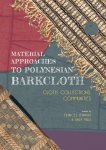Material Approaches to Polynesian Barkcloth Cloth, Collections, Commun
| Schrijver: | |
|---|---|
| Titel: | Material Approaches to Polynesian Barkcloth Cloth, Collections, Communities |
| ISBN: | 9789088909726 |
| Taal: | Engels |
| Uitgever: | Sidestone Press Academics |
| Bijzonderheden: | Als nieuw, Hardback, 330p |
| Prijs: | € 95,00 |
| Verzendkosten: | € 3,50 (binnen Nederland) |
| Meer info: |
Barkcloth or tapa, a cloth made from the inner bark of trees, was widely used in place of woven cloth in the Pacific islands until the 19th century. A ubiquitous material, it was integral to the lives of islanders and used for clothing, furnishings and ritual artefacts. Material Approaches to Polynesian Barkcloth takes a new approach to the study of the history of this region through its barkcloth heritage, focusing on the plants themselves and surviving objects in historic collections. This object-focused approach has filled gaps in our understanding of the production and use of this material through an investigation of this unique fabric’s physical properties, transformation during manufacture and the regional history of its development in the 18th and 19th centuries.\n\nThe book is the outcome of a research project which focused on three important collections of barkcloth at The Hunterian, University of Glasgow; Royal Botanic Gardens, Kew and the National Museum of Natural History, Smithsonian Institution. It also looks more widely at the value of barkcloth artefacts in museum collections for enhancing both contemporary practice and a wider appreciation of this remarkable fabric. The contributors include academics, curators, conservators and makers of barkcloth from Oceania and beyond, in an interdisciplinary study which draws together insights from object-based and textual reseach, fieldwork and tapa making, and information on the plants used to make fibres and colourants.\n\nThis book will be of interest to tapa makers, museum professionals including curators and conservators; academics and students in the fields of anthropology, museum studies and conservation; museum visitors and anyone interested in finding out more about barkcloth.\n\nContents:\n\nAcknowledgements\nImage credits\nBiographies\n\nIntroduction\nFrances Lennard\n\nPart I: Tapa as Fabric: Bast and Colourants\n\nThe procurement, cultural value and fabric characteristics of Polynesian tapa species\nAndy Mills\n\nPlant profile 1. Paper mulberry, Broussonetia papyrifera\nPlant profile 2. Breadfruit, Artocarpus altilis\nMark Nesbitt\n\nTechnical variation in historical Polynesian tapa manufacture\nAndy Mills\n\nBreadfruit tapa: not always second best\nMichele Austin Dennehy, Jean Chapman Mason, Adrienne L. Kaeppler\n\nPlant profile 3. Pacific banyan, Ficus prolixa\nPlant profile 4. Māmaki, Pipturus albidus\nMark Nesbitt\n\nA new perspective on understanding Hawaiian kapa-making\nLisa Schattenburg-Raymond\n\nPolynesian tapa colourants\nAndy Mills, Taoi Nooroa, Allan Tuara\n\nPlant profile 5. Beach hibiscus, Sea hibiscus, Hibiscus tiliaceus\nPlant profile 6. ‘Ākia, Wikstroemia uva-ursi\nMark Nesbitt\n\nHawaiian dyes and kapa pigments: a modern perspective and brief analysis of the historic record\nLisa Schattenburg-Raymond\n\nPart II: Understanding Tapa in Time and Place\n\nTowards a regional chronology of Polynesian barkcloth manufacture\nAndy Mills\n\nLiving with tapa and the social life of ritual objects\nAdrienne L. Kaeppler\n\nPlant profile 7. ‘Oloa, Neraudia melastomifolia\nPlant profile 8. Polynesian arrowroot, Tacca leontopetaloides\nMark Nesbitt\n\nWest Polynesian dyes and decorations as cultural signatures\nAdrienne L. Kaeppler\n\n‘A classification of Tongan ngatu’: change and stability in Tongan barkcloth forms since 1963\nBillie Lythberg\n\nWhite for purity, brown for beautiful like us and black because it is awesome\nFanny Wonu Veys\n\nPlant profile 9. Koka, Bischofia javanica\nPlant profile 10. Candlenut, Aleurites moluccana\nMark Nesbitt\n\nBarkcloth from the islands of Wallis (‘Uvea) and Futuna\nHélène Guiot\n\nBarkcloth in the Māori world\nPatricia Te Arapo Wallace\n\n‘Ahu Sistas: reclaiming history, telling our stories\nPauline Reynolds, Jean Clarkson\n\nPlant profile 11. Turmeric, Curcuma longa\nPlant profile 12. Noni, Morinda citrifolia\nMark Nesbitt\n\n‘Tataki ʻe he Leá: Guided Language’\nTui Emma Gillies, Sulieti Fieme’a Burrows\n\nPart III: Tapa in Collections and the Community\n\nThe Hunterian’s Polynesian barkcloth collection\nAndy Mills\n\nFrom maker to museum: Polynesian barkcloth at the Royal Botanic Gardens, Kew\nMark Nesbitt, Brittany Curtis, Andy Mills\n\nPlant profile 13. Mati, Ficus tinctoria\nPlant profile 14. Tou, Cordia subcordata\nPlant profile 15. Ironwood, Casuarina equisetifolia\nMark Nesbitt\n\nSmithsonian Institution barkcloth collections\nAdrienne L. Kaeppler\n\n‘Holomua ka hana kapa’: a symposium on caring for kapa and kapa makers at the Bernice Pauahi Bishop Museum, December 2017\nAlice Christophe\n\nFiji masi and the Auckland Museum Pacific Collection Access Project\nFuli Pereira, Leone Samu-Tui\n\nPlant profile 16. Malay apple, Syzygium malaccense\nPlant profile 17. Red mangrove, Rhizophora mangle\nMark Nesbitt\n\nShown to full advantage: conservation and mounting of barkcloth for display in the ‘Shifting Patterns: Pacific Barkcloth Clothing’ exhibition at the British Museum\nMonique Pullan\n\nConservation as part of ‘Situating Pacific Barkcloth in Time and Place’: improving preservation, enhancing access and sharing knowledge\nFrances Lennard, Reggie Meredith Fitiao, Su’a Tupuola Uilisone Fitiao, Ruby Antonowicz-Behnan, Beth Knight\n\nAfterword: Polynesian barkcloth past, present, future\nMark Nesbitt, Frances Lennard and Andy Mills\n\nBibliography
|

De verkoper zal binnen 3 werkdagen contact met u opnemen om de koop verder af te handelen.

